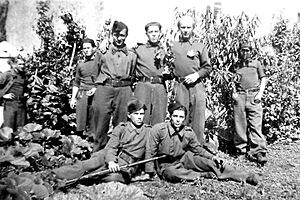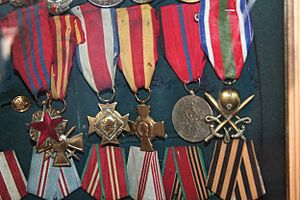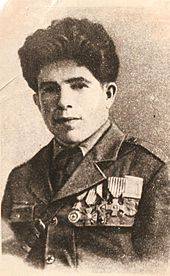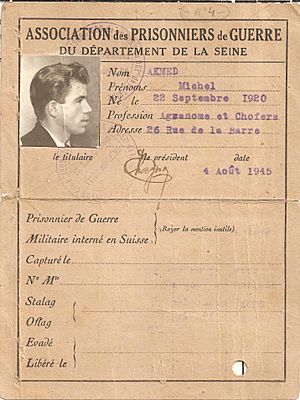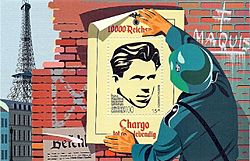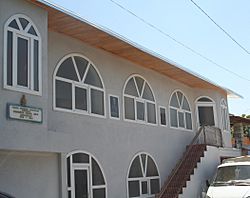Ahmadiyya Jabrayilov facts for kids
Quick facts for kids
Ahmadiyya Jabrayilov
Əhmədiyyə Cəbrayılov |
|
|---|---|
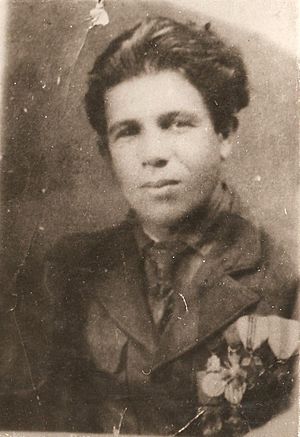
Photo of Ahmadiyya Jabrayilov with his French medals (including Médaille militaire, Croix de Guerre, Medal for the War Wounded, Combatant's Cross and Croix des services militaires volontaires)
|
|
| Birth name | Akhmediya Mikhailovich Dzhabrailov |
| Other name(s) | Ahmed Michel, Akmed Michel, Kharko (Karko) |
| Born | 22 September 1920 Oxud, Shaki Rayon, Azerbaijan SSR |
| Died | 11 October 1994 (aged 74) Shaki, Azerbaijan |
| Allegiance | |
| Service/ |
Partisans |
| Years of service | 1941–1945 |
| Rank | Lieutenant |
| Commands held | Reconnaissance and sabotage group (debatable) |
| Awards | Médaille militaire, Croix de Guerre, Combatant's Cross, Insignia for the Military Wounded, Croix des services militaires volontaires (fact of decoration is debatable) |
Ahmadiyya Mikayil oghlu Jabrayilov (Azerbaijani: Əhmədiyyə Mikayıl oğlu Cəbrayılov, Russian: Ахмедия Микаил оглы Джебраилов; French: Akmed Michel; 22 September 1920 – 11 October 1994) was an Azerbaijani man who is said to have been a member of the French Resistance during World War II. The stories about his life and actions during the war are widely discussed and some parts are disputed.
Contents
Biography
Ahmadiyya Jabrayilov was reportedly born in Okhud village, Shaki District, Azerbaijani SSR, on 22 September 1920. In 1941, he joined the Soviet Army.
His Story During the War
According to some reports, Jabrayilov was captured by enemy forces near Kharkov-Izyum. He was held in a prison camp, where he tried to escape several times. In a camp near Toulouse, a French cleaning woman named Jeanne reportedly helped him. She convinced the camp leader to let her bury him, but instead, he was secretly helped to escape.
After his escape, Jabrayilov is said to have joined the French partisans, also known as the Resistance. He worked with a group led by Captain Gaston Delplanque. They carried out dangerous missions, like blowing up trains and bridges. They also stopped French people from being sent to forced labor camps in Germany.
In one story, Jabrayilov was wounded while disguised in a German uniform. He was taken to a German hospital, but he managed to escape. He is also said to have helped liberate cities like Bordeaux and Paris. During the liberation of Bordeaux, he reportedly led a group through the sewers to surprise the enemy.
After the liberation of Paris, he supposedly met with Maurice Thorez, a leader of the Communist Party. Thorez is said to have given Jabrayilov several high French awards, including the "War Cross" and the "Military Medal". Some accounts even say these awards allowed him to march ahead of French generals in parades.
Other stories mention Jabrayilov fighting in different cities like Montauban, Lyon, Marseille, Toulouse, Dijon, Colmar, and Strasbourg. He was reportedly wounded multiple times.
Some accounts also claim that Jabrayilov met with Charles de Gaulle, the leader of the Free French Forces, on several occasions. One story says de Gaulle called him "his son" after Jabrayilov uncovered a disguised German officer. It is also claimed that de Gaulle wanted to visit Jabrayilov in his home village in Azerbaijan.
Jabrayilov was reportedly awarded the title of "National Hero of France" and the Legion of Honor. Some sources even suggest he worked in Charles de Gaulle's office after the war. There are also claims that an automobile factory in Dijon was named after him.
Questions About His Story
Over time, questions have been raised about the details of Ahmadiyya Jabrayilov's wartime story. In 2015, articles about him were removed from the Russian and French Wikipedias. This happened because there were many contradictions in the different stories and some documents were questioned.
For example, some French military archives said they had no record of a person named "Ahmadiyya Jabrayilov" or "Michel Akmed" participating in the Resistance. One archive did confirm his involvement from August 1944, but only mentioned a single medal, which was given to many people connected to the Resistance.
Documents displayed in his house-museum in Azerbaijan have been found to contain grammatical mistakes in French. Also, a medal for the First World War was seen on a photo of Jabrayilov in the museum, which would not make sense for someone fighting in World War II.
Some historians and journalists have noted that the official stories about World War II heroes in the Soviet Union were sometimes exaggerated. This means that while Jabrayilov may have been involved in the Resistance, some of the more dramatic details of his story might have been added later.
However, some Azerbaijani historians say they have found documents that prove Jabrayilov fought bravely with the French Army until March 1945.
After the War
After the war, Ahmadiyya Jabrayilov returned to Azerbaijan. In 1960, he became a member of the Communist Party of the Soviet Union.
In 1970, he graduated from Azerbaijan State Agricultural University. He worked as an agronomist (a scientist who studies crops and soil) at a kolkhoz (a collective farm) in Shaki Rayon. He also took part in important meetings of the Communist Party of Azerbaijan.
Jabrayilov visited France several times in the 1970s. He met with his former comrades from the Resistance. In 1985, he received the Order of the Patriotic War (second class) from the Soviet Union. He also received other Soviet awards, like the Order of the Red Banner of Labour and the Order of the October Revolution.
In 1990, his son, Mikayil Jabrayilov, who was a police major, was killed. He was later honored as a National Hero of Azerbaijan.
Ahmadiyya Jabrayilov died in Shaki, Azerbaijan on 11 October 1994. He was reportedly hit by a truck while using a telephone box.
Legacy
Ahmadiyya Jabrayilov is remembered in Azerbaijan through various works. Several Soviet plays, stories, and documentary films have been made about him. In 1975, an Azerbaijani film called Hero of France [az] was made about his life.
A bronze monument of Jabrayilov was placed over his grave in Okhud village cemetery. One of the streets in Shaki is also named after him.
There is a house-museum dedicated to Ahmadiyya Jabrayilov in Shaki. His son, Javanshir Jabrayilov, helped create and manage this museum.
In 2007, the French embassy in Azerbaijan, along with a French cultural center and the Shaki museum, held an exhibition about his life. It was called He was called Armed Michele in France and showed photos, documents, and a film about him.
In 2016, a plaque with Jabrayilov's portrait was unveiled near Montauban, France. This was part of a ceremony to remember him and other Azerbaijani members of the French Resistance.
Sources
- Photograph
- Джабраилов Ахмедия Микаилович (Армед Мишель). «Разведка и контразведка в лицах» — Энциклопедический словарь российских спецслужб. Автор-сост. А. Диенко, предисл. В. Величко. — М.: Русскій міръ, 2002.
- Trend Life: Бонжур, камарад!
- Саваш — военно-исторический сайт. Партизаны
- Вышка № 45 от 21 ноября 2003 года. Памяти азербайджанских маки
- Семиряга М. И. Советские люди в европейском Сопротивлении, М., 1970
- А.Н.Шлепаков. Антифашистская солидарность в годы второй мировой войны, 1939–1945 гг. К.: Наук.думка, 1987. [1]
- Против общего врага. Советские люди во французском движении сопротивления. Академия Наук СССР, Институт военной истории Министерства обороны. М. Наука, 1972. [2]
See also
 In Spanish: Ahmadiyye Jabrayilov para niños
In Spanish: Ahmadiyye Jabrayilov para niños


